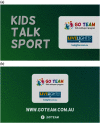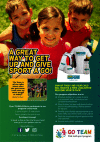Parents' reactions to unhealthy food v. pro-health sponsorship options for children's sport: an experimental study
- PMID: 31915086
- PMCID: PMC10200523
- DOI: 10.1017/S1368980019003318
Parents' reactions to unhealthy food v. pro-health sponsorship options for children's sport: an experimental study
Abstract
Objective: To explore parents' responses to sponsorship of children's sport by unhealthy food brands and two alternative pro-health sponsorship options.
Design: Between-subjects online experiment with four sponsorship conditions: (i) non-food branding (control); (ii) unhealthy food branding; (iii) healthier food branding; (iv) public health nutrition campaign branding. Participants were shown a short video and a promotional flyer for a fictional junior sports programme, with sponsor content representing their assigned brand. Afterwards, participants were asked a series of questions assessing their brand awareness, brand attitudes and preference for food sponsor branded products.
Setting: Australia.
Participants: Australian parents (n 1331) of children aged 6-9 years.
Results: Compared with the control condition, unhealthy food sponsorship promoted increased awareness, branded product preferences and favourable attitudes towards unhealthy food sponsor brands. Healthier food sponsorship promoted similar effects for healthier food sponsor brands, except there was no significant increase in positive attitudes towards these brands. Sponsorship by public health nutrition campaigns promoted more negative attitudes towards unhealthy food sponsor brands and increased preference for healthier food sponsor branded products. Overall, healthier food sponsors and public health campaign sponsors were perceived to have better programme-sponsor fit and to be more appropriate sponsors of children's sport than unhealthy food sponsors.
Conclusions: Restrictions on unhealthy food sponsorship of children's sport are needed to prevent unhealthy food brands from exploiting junior sport sponsorship to enhance their appeal. Sponsorship of children's sport by healthier food brands or public health nutrition campaigns could help promote healthier food choices among parents.
Keywords: Children’s sport; Experiment; Obesity; Parents; Public health nutrition; Sport sponsorship.
Figures




 , non-food branding;
, non-food branding;  , unhealthy food branding;
, unhealthy food branding;  , healthier food branding;
, healthier food branding;  , public health nutrition campaign branding) among Australian parents of children aged 6–9 years (n 1331). 95 % confidence intervals are represented by vertical bars. Logistic regression analyses included product category and brand set as covariates. ***P < 0·001; †reference category for logistic regression analyses
, public health nutrition campaign branding) among Australian parents of children aged 6–9 years (n 1331). 95 % confidence intervals are represented by vertical bars. Logistic regression analyses included product category and brand set as covariates. ***P < 0·001; †reference category for logistic regression analyses
 , non-food branding;
, non-food branding;  , unhealthy food branding;
, unhealthy food branding;  , healthier food branding;
, healthier food branding;  , public health nutrition campaign branding) among Australian parents of children aged 6–9 years (n 1331). 95 % confidence intervals are represented by vertical bars. Logistic regression analyses included product category and brand set as covariates. *P < 0·05, **P < 0·01; †reference category for logistic regression analyses
, public health nutrition campaign branding) among Australian parents of children aged 6–9 years (n 1331). 95 % confidence intervals are represented by vertical bars. Logistic regression analyses included product category and brand set as covariates. *P < 0·05, **P < 0·01; †reference category for logistic regression analyses
 , non-food branding;
, non-food branding;  , unhealthy food branding;
, unhealthy food branding;  , healthier food branding;
, healthier food branding;  , public health nutrition campaign branding) among Australian parents of children aged 6–9 years (n 1331). 95 % confidence intervals are represented by vertical bars. Linear regression analyses included product category and brand set as covariates. *P < 0·05, **P < 0·01; †reference category for linear regression analyses
, public health nutrition campaign branding) among Australian parents of children aged 6–9 years (n 1331). 95 % confidence intervals are represented by vertical bars. Linear regression analyses included product category and brand set as covariates. *P < 0·05, **P < 0·01; †reference category for linear regression analyses
 , non-food branding;
, non-food branding;  , unhealthy food branding;
, unhealthy food branding;  , healthier food branding;
, healthier food branding;  , public health nutrition campaign branding) among Australian parents of children aged 6–9 years (n 1331). 95 % confidence intervals are represented by vertical bars. Linear regression analyses included product category and brand set as covariates. *P < 0·05, ***P < 0·001; †reference category for linear regression analyses
, public health nutrition campaign branding) among Australian parents of children aged 6–9 years (n 1331). 95 % confidence intervals are represented by vertical bars. Linear regression analyses included product category and brand set as covariates. *P < 0·05, ***P < 0·001; †reference category for linear regression analyses
 , non-food branding;
, non-food branding;  , unhealthy food branding;
, unhealthy food branding;  , healthier food branding;
, healthier food branding;  , public health nutrition campaign branding) among Australian parents of children aged 6–9 years (n 1331). 95 % confidence intervals are represented by vertical bars. Linear regression analyses included product category and brand set as covariates. ***P < 0·001; †reference category for linear regression analyses
, public health nutrition campaign branding) among Australian parents of children aged 6–9 years (n 1331). 95 % confidence intervals are represented by vertical bars. Linear regression analyses included product category and brand set as covariates. ***P < 0·001; †reference category for linear regression analysesSimilar articles
-
Community junior sport sponsorship: an online experiment assessing children's responses to unhealthy food v. pro-health sponsorship options.Public Health Nutr. 2018 Apr;21(6):1176-1185. doi: 10.1017/S1368980017003561. Epub 2017 Dec 6. Public Health Nutr. 2018. PMID: 29208078 Free PMC article.
-
The impact of unhealthy food sponsorship vs. pro-health sponsorship models on young adults' food preferences: a randomised controlled trial.BMC Public Health. 2018 Dec 20;18(1):1399. doi: 10.1186/s12889-018-6298-4. BMC Public Health. 2018. PMID: 30572864 Free PMC article. Clinical Trial.
-
Views of children and parents on limiting unhealthy food, drink and alcohol sponsorship of elite and children's sports.Public Health Nutr. 2013 Jan;16(1):130-5. doi: 10.1017/S1368980012001188. Epub 2012 May 11. Public Health Nutr. 2013. PMID: 22575442 Free PMC article.
-
Sports Sponsorship as a Cause of Obesity.Curr Obes Rep. 2019 Dec;8(4):480-494. doi: 10.1007/s13679-019-00363-z. Curr Obes Rep. 2019. PMID: 31673981 Review.
-
Promoting healthy eating in the community sport setting: a scoping review.Health Promot Int. 2022 Feb 17;37(1):daab030. doi: 10.1093/heapro/daab030. Health Promot Int. 2022. PMID: 33647956
Cited by
-
Food and beverage selection in children's sports arenas in Norway: a cross-sectional study.Public Health Nutr. 2024 Apr 4;27(1):e115. doi: 10.1017/S1368980024000818. Public Health Nutr. 2024. PMID: 38571384 Free PMC article.
-
Adolescents' experiences with the food selection at the sports arena in the area of Oslo, Norway: a focus group study.Public Health Nutr. 2024 Jan 19;27(1):e39. doi: 10.1017/S1368980024000181. Public Health Nutr. 2024. PMID: 38238883 Free PMC article.
-
Choice, Motives, and Mixed Messages: A Qualitative Photo-Based Inquiry of Parents' Perceptions of Food and Beverage Marketing to Children in Sport and Recreation Facilities.Int J Environ Res Public Health. 2022 Feb 23;19(5):2592. doi: 10.3390/ijerph19052592. Int J Environ Res Public Health. 2022. PMID: 35270284 Free PMC article.
-
Testing a nutrient composition threshold model to classify brands for marketing restrictions.PLoS One. 2024 Oct 25;19(10):e0311579. doi: 10.1371/journal.pone.0311579. eCollection 2024. PLoS One. 2024. PMID: 39453920 Free PMC article.
-
A Journey Into School Lunchbox Decision-Making: A Mixed Methods Exploration of Australian Parents.Health Promot J Austr. 2025 Oct;36(4):e70089. doi: 10.1002/hpja.70089. Health Promot J Austr. 2025. PMID: 40827439 Free PMC article.
References
-
- Australian Bureau of Statistics (2012) 4901.0 – Children’s Participation in Cultural and Leisure Activities, Australia, April 2012. Canberra, ACT: ABS.
-
- Watson WL, Brunner R, Wellard L et al.. (2016) Sponsorship of junior sport development programs in Australia. Aust N Z J Public Health 40, 326–328. - PubMed
-
- Meenaghan T & Shipley D (1999) Media effect in commercial sponsorship. Eur J Mark 33, 328–348.
Publication types
MeSH terms
LinkOut - more resources
Full Text Sources
Medical

